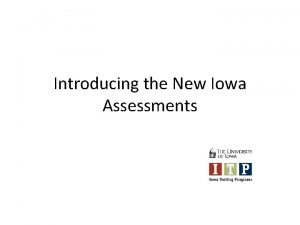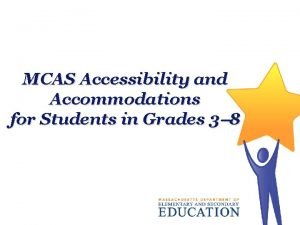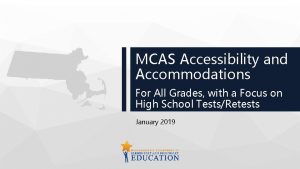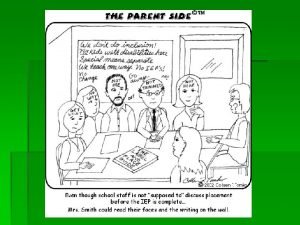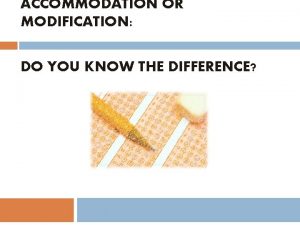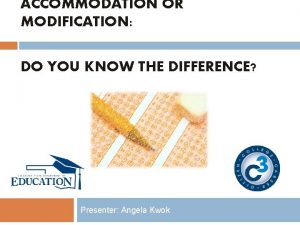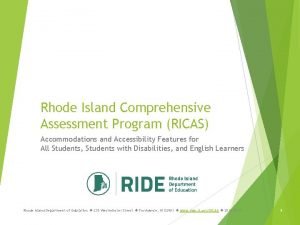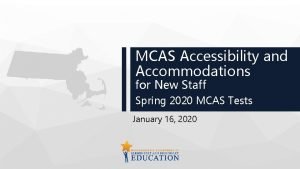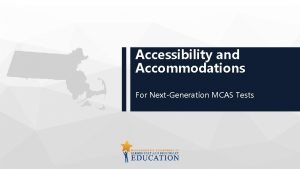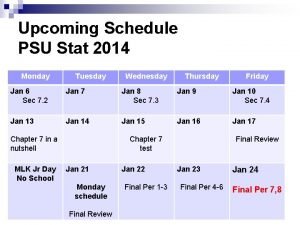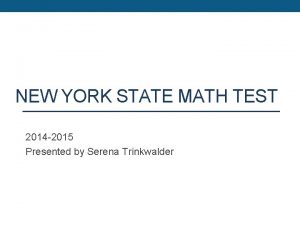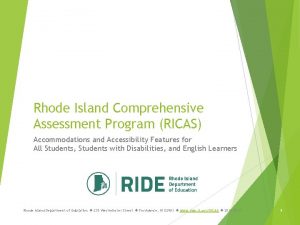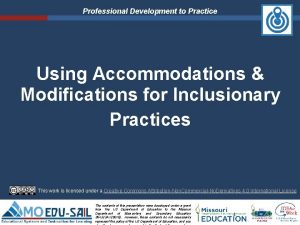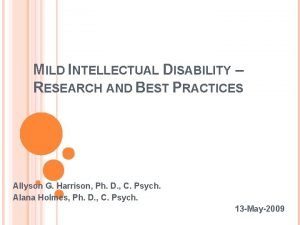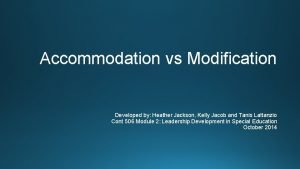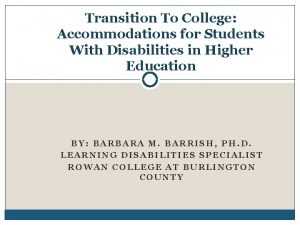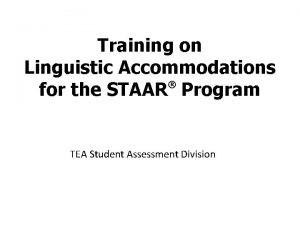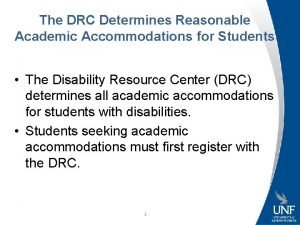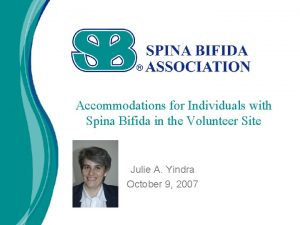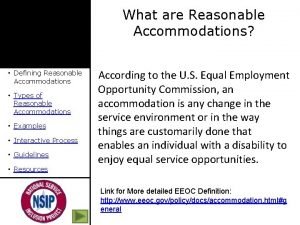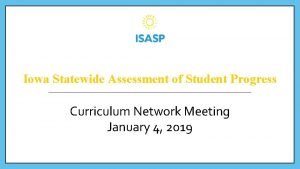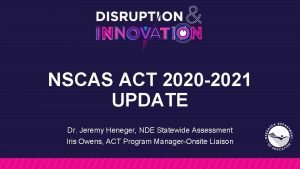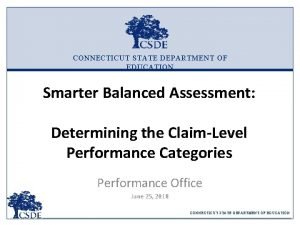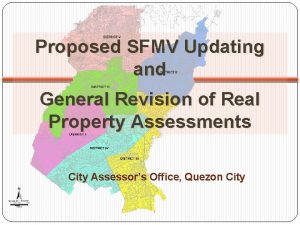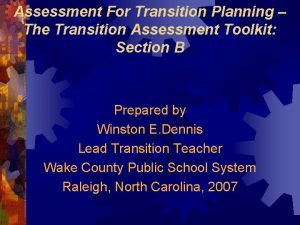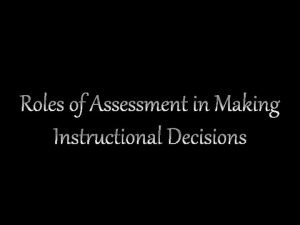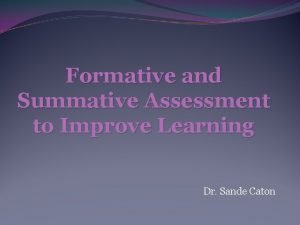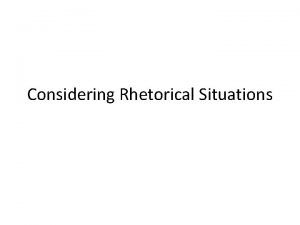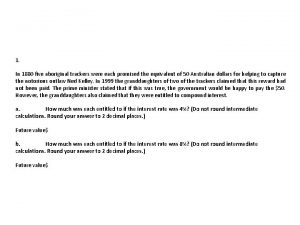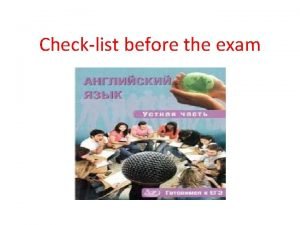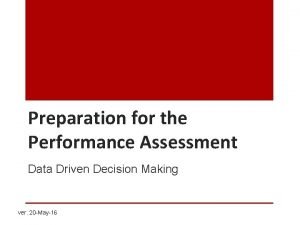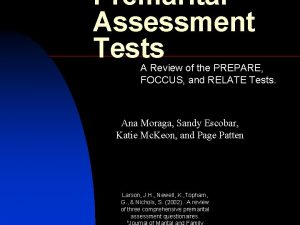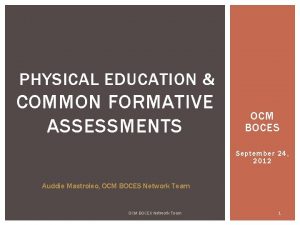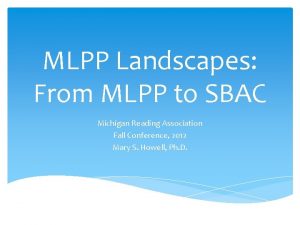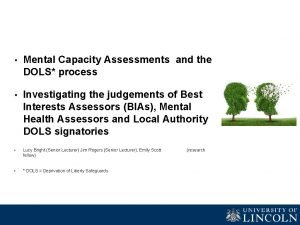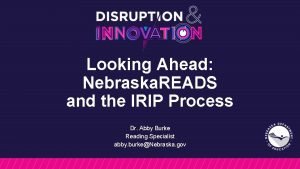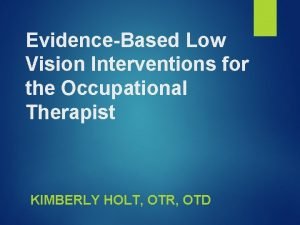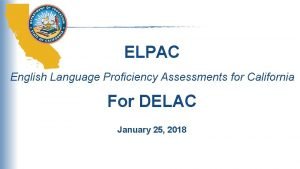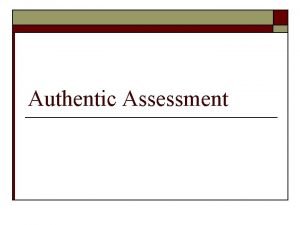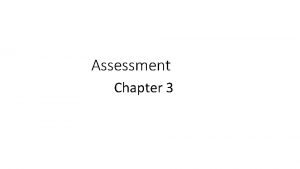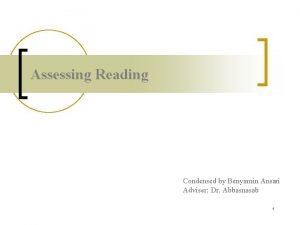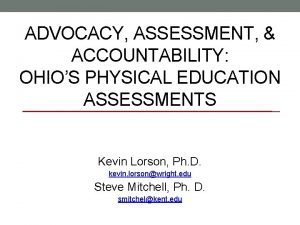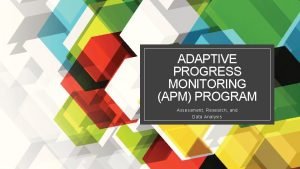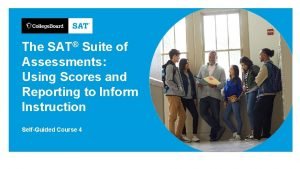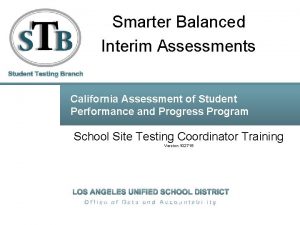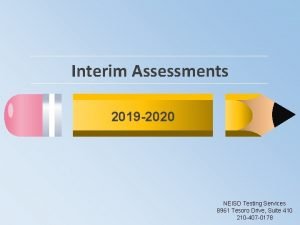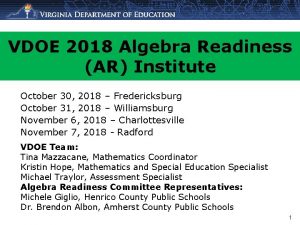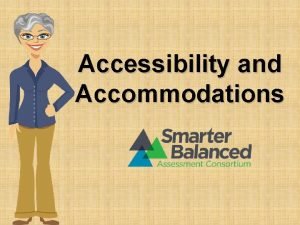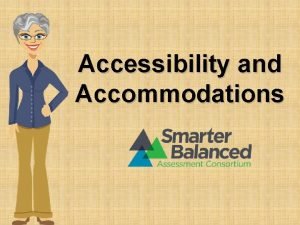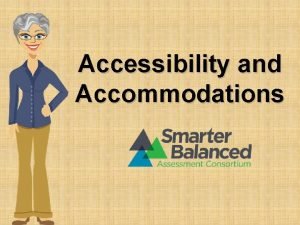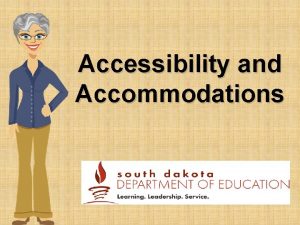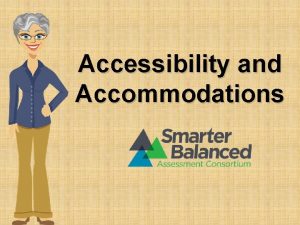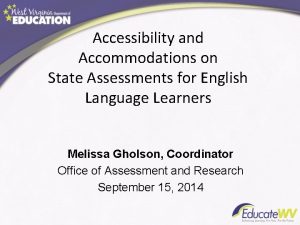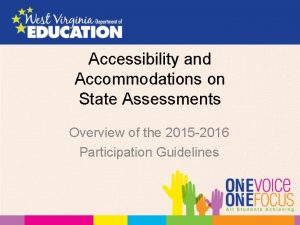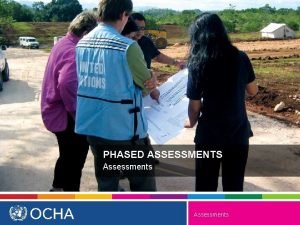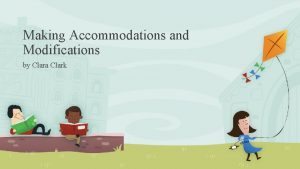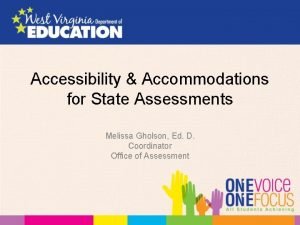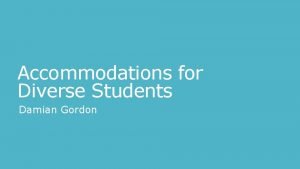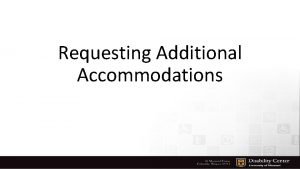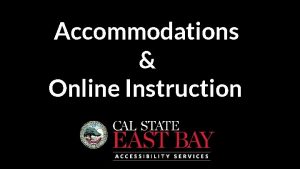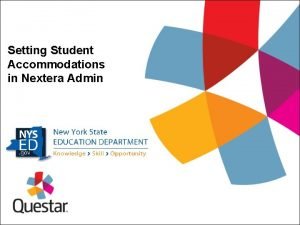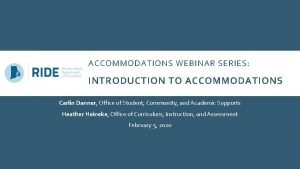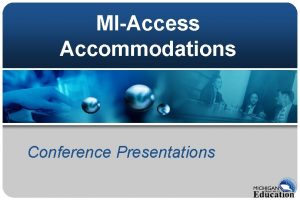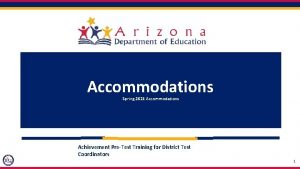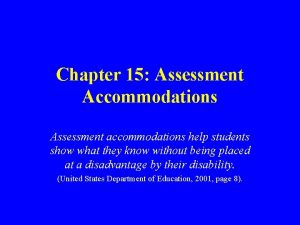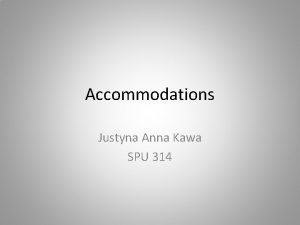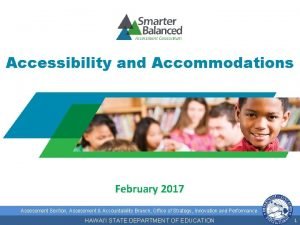Considering Accommodations in State Assessments 2013 2014 and




























































- Slides: 60

Considering Accommodations in State Assessments: 2013 -2014 and Beyond Melissa Gholson, Coordinator Office of Assessment and Accountability

Thinking About Accommodations • Where are we now? • Where are we going? ELPA 21 • What’s our plan to get there?

A Systems Perspective Research Agenda Monitoring Process: WVS 326 Peer Review A Systems Perspectives Participation Guidelines & Policies 2340, 2419, 2417 IEP, 504 and LEP Plans WVEIS Codes/ Descriptions

Current to December 2013 WHERE ARE WE NOW?

Peer Review Guidance • Decisions about how students with disabilities will participate in the assessment system be made on an individual basis • Specify that these decisions must be consistent with the routine instructional approaches as identified by each student’s IEP and/or 504 plan • Assessment accommodations should not be used for the first time on test day

2013 -2014 Participation Guidelines • The document includes references to current state policies and procedures. • The document is revised annually. Use the one posted for ACT PLAN/EXPLORE and COMPASS. • This will be updated again December 1, 2013.

Accommodations Code Summary

2013 -2014 PG Changes • ESEA Updates • COMPASS • Emergency Appeals Process- [Exemptions for Participation Rate/Formerly Medically Fragile] (p. 12) • Home school students coding 999 (page 13) • Updated and clarified accommodations code and information (pages 21 -31) • P 28 -Use high contrast for online assessments (page 26) • Numerical order of accommodations and updated summary sheet (page 31) • NAEP section (page 51)

Accessing the Current Version of the Participation Guidelines • The current version is available electronically at http: //wvde. state. wv. us/oaa/pdf/Participation. Guideline s. pdf • Distribution should be made within your districts either electronically to all members of IEP, 504 and ELL team members and school administration. • It is recommended that all building level coordinators, principals, LEP, 504 or IEP team members have a copy.

ACT PLAN, EXPLORE & COMPASS Reminders and Clarifications • P 02 – Have test read verbatim – is allowed on the reading and English portions of ACT PLAN and EXPLORE • The P 02 may require extra time and need a T 04 • PO 2 is allowed for COMPASS Math and must be provided in a separate setting. • P 02 is not allowed for COMPASS WRITING SKILLS.

Other Considerations • Scribing is different than Online Writing; for COMPASS; the examiner enters the response into the system. This would be considered an R 02. • There is no breach form for ACT PLAN & EXPLORE. Please make sure the accommodations are provided the first time. • P 15 – Have directions only read aloud – applies to all subtests. Only the directions that appear beside the word “Directions” appears in the test booklet can be read aloud.

Prior to Testing: Verification Follow the steps outlines in the Participation Guidelines. • Accommodations should be verified: WVEIS record compared to current IEP • Assessment decisions are made prior to testing. • The only way to change the listed accommodation(s) is by holding an appropriate IEP meeting/addendum.

State Accommodations Monitoring Policies • West Virginia Policies: 2340, 2419, 2417 provide guidance for accommodations for students with IEP, 504 and LEP plans. • All required district and state assessments must provide accommodations monitoring using the WVS. 326 Process. • Students should always receive the accommodations identified in their plans for other assessments. Individual accommodations data is archived in the West Virginia Education Information System (WVEIS). • All corrections for accommodations must be made at the district level. 13

The 326 Process • The WVS. 326 form will be provided for all WV-MAP assessments. • One form will be provided for each student who should receive accommodations. • WVS. 326 video http: //wvde. state. wv. us/oaa/videos/WV_32 6/Documentation%20 Procedures. zip

During the Assessment • Page 2 must have data entered for each accommodation identified on page 1. • If you provide an accommodation not identified on page 1, you have over-accommodated a student. • You may add an accommodation to a pre-slugged form; if you need to delete an accommodation, a new form must be filled out • Teachers/BLC review forms daily at the site to assure they are documenting correctly • Report errors to Principal/BLC

Expect Form Changes Accommodations selected must match current IEP, LEP or 504 plan.

WVS. 326 Accommodations Form Changes Required accommodations to be provided may be highlighted here.

Let’s Talk About Codes If you mark Provided “yes”- this means the student was given the identified accommodation If you mark “No” means-the student was not provided the identified accommodation. This is an accommodations breach UNLESS • Code 1 -the student refused • Code 2 -the accommodation is not allowed/applicable for this test If “no” is not marked with a code 1 or 2, then it constitutes an accommodations error.

Common Errors in Filling Out the WVS. 326 Form Over-accommodating • Selecting yes on back when front is not bubbled. • Selecting Yes on back when accommodation was not allowed, not applicable Under-accommodating • Failing to provide any data on page 2 • Selecting “No” and failing to identify a code 1 (refused) or code 2 (not allowed/not applicable)

Training Issues Reasons for errors • Confusing form layout • Not understanding when specific accommodations are allowed for a test. • Inappropriate use of the not applicable/not allowable reason code • Accommodations not in the pre-slug • Leaving the back of the sheet blank How to Fix • Change to 2 forms • Retrain on table in Participation Guidelines • Clarify how to use NA reason code • Retrain on how to add an accommodation not in preslug • Remind BLCs that examiners should review sheets before submitting

What to do about students who do not receive accommodations? All incidents for failing to provide an accommodation requires written documentation. • • The CTC will review all accommodation breaches with principals/building level coordinators and report any findings to the Special Education, Title III and/or 504 director(s) and to the Office of Assessment and Accountability. If a student has been denied accommodations listed within the IEP, 504 or LEP plan, there has been a breach in the integrity/accuracy of test results. Therefore, the CTC or county special education director should contact the principal who must inform the parent/guardian of the testing administration breach and provide the following options: – Test is invalidated and the student is retested using a breach form (if the testing window is still open). – Test is scored. – Test is invalidated and student receives a score of ― 0. If the second or third option is selected—there must be a signed written agreement between the parent/guardian and principal/building level coordinator. Copies of the agreement must be kept on file with the CTC/county special education director, Section 504 director, or Title III director.

WVS 326 State and District Accommodations Report • Analyzed provision data for 2012 WESTEST 2 by content area • 7 reports were generated for each content area to summarize (1) provision rate, (2) refusal rate, (3) not allowable rate, and (3) number of students overaccommodated – – – State, district, school-level reports Intended uses of these data Set specific targets for provision rates Identify common errors to inform your training Eliminate under- and over-accommodation

WVS. 326 Accommodations Reporting 1. Count of Students with Accommodation 2. Provision Rate 3. Not Allowed Rate 4. Refusal Rate 5. Not Provided (no reason indicated) 6. Not Provided (blank) 7. Count of Students Overaccommodated This report provides the total number of students with the accommodation listed on the front of the 326 form (this number serves as the denominator for all rate calculations in reports 2 – 6). This report provides the percentage of students with the accommodation for whom the accommodation was marked “provided. ” This report provides the percentage of students with the accommodation for whom the accommodation was marked “not provided” and the “not allowed” code was provided in the reason field. This report provides the percentage of students with the accommodation for whom the accommodation was marked “not provided” and the “refused” code was provided in the reason field. This report provides the percentage of students with the accommodation for whom the accommodation was marked “not provided” but no reason code was provided. This report provides the percentage of students for whom no information was provided on whether or not the accommodation was provided. This report provides the number of students who do not have the accommodation listed in the pre-slug file, but for whom the accommodation was marked “provided. ”

State Reports

District Reports

WHERE ARE WE GOING?

Updating WVEIS Accommodations Codes • A Quick sheet containing all accommodations codes. • Bold codes are embedded • New codes or updated definitions are highlighted • Will be included in the updated PG, WVEIS…

ACCOMMODATIONS AND THE ONLINE IEP








Data Collections for Accommodations SY 2013 -2014 • ACT Plan & Explore: September 9, 2013 • Writing Assessment: Validation window Jan 2 -10, Initial Closure Date Jan. 10, Certification window January 11 -15, Certification due date Jan. 15 by 11: 59 p. m. • WESTEST 2: February 28 • APTA: March 15

Selection of accommodations are documented in the IEP Accommodations provision data is collected, analyzed and reports created The Accommodations Process Data from WVEIS is pulled to identify the appropriate accommodations Accommodations data must be entered into WVEIS Accommodations data must be verified prior to assessment

Accommodation Issues • Accommodations are formally documented in the IEP. • Going forward the Online IEP must be finalized if we are able to obtain the accommodations information for systems reporting. • Hard copies of IEPs are currently hand entered into WVEIS at the district level. High rates of human error and are not completed in a timely manner consistent with data collection deadlines. • The accommodations must verified prior to each state assessment window. The case manager at each school or the teacher assigned should be able to have the most current information for verification. • The data for the WVS 326 forms is only as correct as the data entered. The information on the WVS 326 forms is populated directly from the data entered at the district.

Accommodations Checklist • • Identify who needs trained: All district staff (including CTC’s, Special Education Directors and district staff, 504 Coordinators, ELL Coordinators), all principals/BLC’s, special education teachers and test examiners. Identify what training needs provided: Train on changes to the Participation Guidelines , accommodations, forms, data entry, collection dates and monitoring forms. Identify a method/timeframe for training, discussion Model changes made to the LEP, 504 & Online IEP forms, new or revisions for accommodations specific for each assessment (WESTEST 2 Online and Smarter Balanced Field Test). Collection dates need to be emphasized. Disseminate the importance of identifying embedded accommodations in advance of collection dates in order for the student to obtain embedded accommodations. Follow up: Review IEP’s, 504’s and LEP’s for any changes necessary regarding changes for accommodations. Conduct any addendums or meetings for students to be eligible to receive the appropriate accommodation prior to collection dates. Districts must verify and record each student who receives accommodations. This means the Online IEP must be finalized. (Currently it means the green screen). The WVS. 326 form should be reviewed prior to each assessment.

Overwhelmed?

HOW DO WE GET THERE?

Transition Plan Recommendations • Review the current codes and review the proposed accommodations for WESTEST 2 Online. • Make sure the appropriate accommodations are finalized into the IEP • Review and consider Smarter Balanced accommodations as of April 1, 2014. (Earlier if they are taking a field test this spring).

WESTEST 2 Online Accommodation Codes • P 02 Have test read aloud -WESTEST 2 online will provide an embedded human recorded voice ; or may be administered individually by a trained examiner. • P 03 Use contracted braille or tactile graphics • P 06 Have test presented through sign language • P 15 Have directions only read aloud –Provided by a human only /no recording of directions only • P 16 Have directions presented through sign language • P 17 Use secure electronic braille note taker • P 18 Have directions rephrased by trained examiner • P 19 Use large print edition • P 21 Use screen reading software • P 22 Enlarge text on screen (Large Font Size)

WESTEST 2 Codes (continued) • • • P 23 P 24 P 25 P 26 P 27 P 28 • • P 29 R 02 R 03 R 04 • R 05 Use a magnifying device to enlarge assessment material Use electronic translator or sign-dictionary to present test Use electronic translator or sign dictionary to present directions only Have directions, passage and prompt read aloud Use approved bilingual word to word dictionary Use high contrast on screen (For WESTEST 2 Online the student will be able to receive color font and background options) Use sign-dictionary to present test, including directions Indicate responses to a scribe (multiple-choice) Use braille or tactile graphics Indicate responses to a scribe (constructed, extended and gridded response) Use an abacus

WESTEST 2 Codes (Continued) • R 11 Use computer or other assistive technology device to respond • R 13 Provide physical support • R 15 Use a bilingual word to word dictionary • R 16 Mark responses in large-print test book • R 17 Use an electronic translator to respond • T 03 Take more breaks (no studying) • T 04 Use extra time for any timed test (extended time) (NAEP, ACT Explore and Plan are timed) • T 07 Flexible scheduling, same day

Smarter Balanced website has more specific guidelines on • General Accessibility Guidelines • ELA Audio Guidelines • Mathematics Audio Guidelines • ELL Guidelines • Signing Guidelines • Tactile Guidelines • Bias and Sensitivity Guidelines • Style Guide



Universal Tools Embedded • Breaks • Calculator • Digital Notepad • English Dictionary • English Glossary • Expandable Passages • Global Notes • Highlighter • Keyboard Navigation • Mark for Review • Math Tools • Spell Check • Strikethrough • Writing Tools • Zoom Non-embedded • Breaks • English Dictionary • Scratch Paper • Thesaurus

Designated Supports Embedded • Color Contrast, • Masking • Text-to-speech • Translated Test Directions • Translations (Glossary) • Translations (Stacked) • Turn off Any Universal Tools Non-embedded • Bilingual Dictionary • Color Contrast • Color Overlay • Magnification, • Read Aloud • Scribe • Separate Setting

Accommodations Embedded • American Sign Language • Braille • Closed Captioning • Text-to-speech Non-embedded • Abacus • Alternate Response Options • Calculator • Multiplication Table • Print on Demand • Read Aloud • Scribe • Speech-to-text

• P 01 Smarter Balanced Field Test Reading Supports Use text to speech, excluding ELA reading passages (Smarter Balanced & NAEP) • P 02 Have test read aloud (All WV-MAP tests excluding Smarter Balanced ELA reading passages, WESTEST 2 RLA/Online Writing, ACT COMPASS Writing Skills and NAEP Reading) • P 13 Use text to speech, including ELA reading passages (Smarter Balanced –for documented need, grades 6 -11) • P 14 Have test read aloud, including passages (Smarter Balanced –for documented need for grades 6 -11; students who are blind/low vision grades 3 -11 who do not yet have adequate braille skills)

Smarter Balanced • P 03 Use contracted braille or tactile graphics (All WV-MAP tests excluding NAEP computer-based) • P 28 Use high contrast on screen (Smarter Balanced, WESTEST 2 and Online Writing, ACT COMPASS, NAEP, and other computer based assessments) • P 33 Turn off any universal tools (Smarter Balanced) • P 34 Use embedded American Sign Language (Smarter Balanced – for ELA listening and math items only ) • P 35 Use non-contracted braille and tactile graphics (Smarter Balanced) • P 36 Use closed captioning (Smarter Balanced – for ELA listening and NAEP) • P 37 Use masking (Smarter Balanced)

Smarter Balanced • P 38 in • P 39 • P 40 • R 05 Use color contrast (Smarter Balanced – conjunction with print on demand) Use color overlays (Smarter Balanced – in conjunction with print on demand) Use print on demand (Smarter Balanced) Use an abacus (Smarter Balanced, WESTEST 2 Mathematics and Science, APTA, ACT COMPASS Mathematics, ACT EXPLORE and PLAN)

Smarter Accommodations • R 11 • R 19 • R 20 • R 21 • T 09 Use computer or other assistive technology device to respond (All WV-MAP tests) Use calculator (Smarter Balanced –for students needing a special calculator, e. g. braille or talking) Use multiplication table (Smarter Balanced) Use Speech to Text (Smarter Balanced) Provide separate setting (Smarter Balanced)

ELL-Smarter Balanced • P 30 Provide translated test directions (ELL Smarter Balanced – for math items only) • P 31 Provide translations glossary (ELL Smarter Balanced – for math items only) • P 32 Provide translations stacked (ELL Smarter Balanced – for math items only) • R 15 Use a bilingual word-to-word dictionary (All WV-MAP and Smarter Balanced ELAperformance task full writes excluding WESTEST 2 RLA and Online Writing, ACT COMPASS Writing Skills and NAEP Reading and Writing)

Resources • Make good decisions about who should be on the alternate assessment- Participation Guidelines & Alternate Assessment Standards • Smarter Balanced Accommodations Guidelines • Guidelines for Participation in State Assessment (PG) • Accommodations checklist for WESTEST 2 Online & Smarter Balanced Field Test • Smarter Balanced Practice Tests

Why do we have to improve? “It is not enough to have a list of available accommodations. Rather, accommodations must be used for instruction and assessment, they must be monitored, and they must be used appropriately so that scores are valid and provide information about a student’s knowledge and skills”. (NCEO, 2012)

Questions? Melissa Gholson mgholson@access. k 12. wv. us

 Iowa staewide assessment of student progress
Iowa staewide assessment of student progress Mcas el accommodations
Mcas el accommodations Mcas accommodations list
Mcas accommodations list Accommodations and modifications
Accommodations and modifications Accommodations for speech and language impairment
Accommodations for speech and language impairment Difference in accommodations and modifications
Difference in accommodations and modifications Difference in accommodations and modifications
Difference in accommodations and modifications Rhode island
Rhode island Mcas accommodations manual 2020
Mcas accommodations manual 2020 Mcas accommodations
Mcas accommodations Statistics symbols meaning
Statistics symbols meaning Nys math test 2014
Nys math test 2014 Accommodation personal statement examples
Accommodation personal statement examples Ricas accommodations
Ricas accommodations Types of accommodations
Types of accommodations Types of accommodations
Types of accommodations Accommodations for borderline intellectual functioning
Accommodations for borderline intellectual functioning Accommodations vs modifications chart
Accommodations vs modifications chart Accommodations in college
Accommodations in college Staar writing prompts
Staar writing prompts Drc accomodations
Drc accomodations Accommodations for students with spina bifida
Accommodations for students with spina bifida Types of reasonable accommodations
Types of reasonable accommodations Isasp language/writing practice test
Isasp language/writing practice test Nebraska act test dates
Nebraska act test dates Sbac accommodations ct
Sbac accommodations ct General revision of assessments and property classification
General revision of assessments and property classification Informal assessments for transition planning
Informal assessments for transition planning Disadvantages of formal assessment
Disadvantages of formal assessment Formative diagnostic and summative assessment
Formative diagnostic and summative assessment Physical fitness grade 9
Physical fitness grade 9 Example of formative assessment
Example of formative assessment The holiday meal turkey ranch is considering
The holiday meal turkey ranch is considering Types of advertisement
Types of advertisement Rhetorical situation define
Rhetorical situation define Imperial jewelers is considering a special order for
Imperial jewelers is considering a special order for Johnny's lunches is considering purchasing a new
Johnny's lunches is considering purchasing a new You are considering buying some flowers
You are considering buying some flowers Considering interestrate swaps, the swap rate is
Considering interestrate swaps, the swap rate is Performance assessment examples
Performance assessment examples Premarital tests or assessments
Premarital tests or assessments Formative assessments in physical education
Formative assessments in physical education Scoring rubrics for designing a museum exhibit
Scoring rubrics for designing a museum exhibit Mlpp assessments
Mlpp assessments Six dols assessments
Six dols assessments Irip
Irip Occupational therapy assessments for low vision
Occupational therapy assessments for low vision Elpac
Elpac Cte technical skills assessments.azed.gov/student
Cte technical skills assessments.azed.gov/student Creative arts programme of assessment
Creative arts programme of assessment What does olivia mean
What does olivia mean Authentic tasks meaning
Authentic tasks meaning Characteristics of psychological assessment
Characteristics of psychological assessment Impromptu reading plus comprehension questions
Impromptu reading plus comprehension questions Ode physical education assessments
Ode physical education assessments Fs assessments.org/apm
Fs assessments.org/apm Sat suite of assessments
Sat suite of assessments Lausd interim assessments
Lausd interim assessments Aware online testing neisd
Aware online testing neisd Writing analytical assessments in social work
Writing analytical assessments in social work Vdoe algebra readiness formative assessments
Vdoe algebra readiness formative assessments
